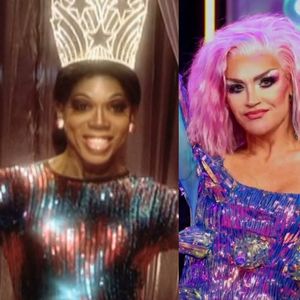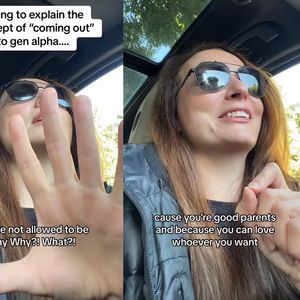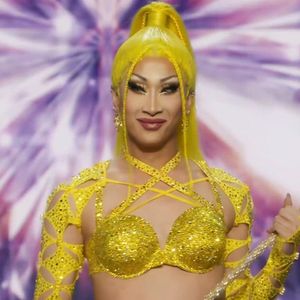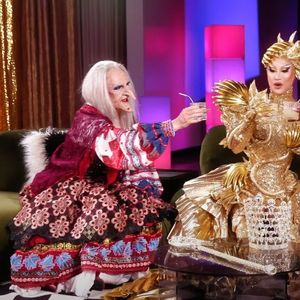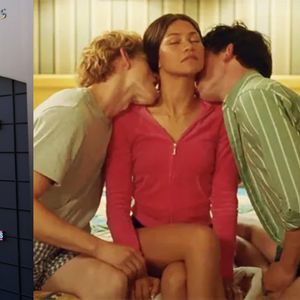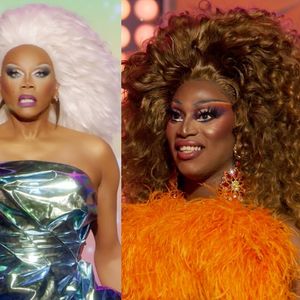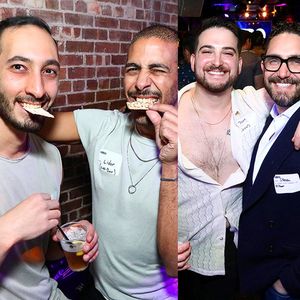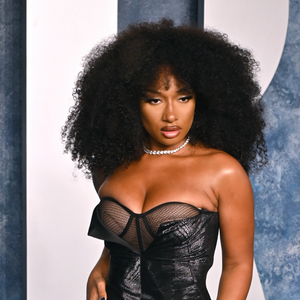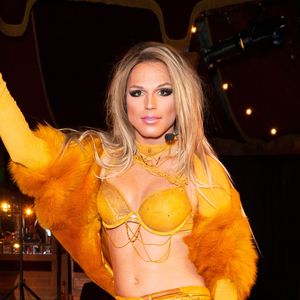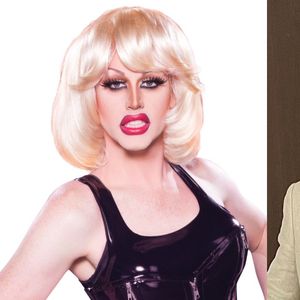Clare Sears's book from Duke University Press, Arresting Dress: Cross-Dressing, Law, and Fascination in Nineteenth-Century San Francisco, reveals in intriguing detail through research into historic law cases, police records, and show business history the many dimensions of what was considered cross-dressing in the late 19th century, and how the laws were used to define and supress transgender expression for decades. The excerpt below is (c) 2015 Duke University Press.
 At right: One of the nation's most famous female impersonators, William Horace Lingard
At right: One of the nation's most famous female impersonators, William Horace Lingard
Gender and Illusion
Given the punitive forces impinging on cross-dressing bodies in nineteenth century San Francisco, their concurrent display in entertainment venues across the city is striking. Nowhere is this more apparent than on the vaudeville stage. During the final decades of the nineteenth century vaudeville developed as a wildly popular form of family entertainment that took San Francisco -- and the nation -- by storm. Adopting the variety-show format of the English music hall, vaudeville productions featured multiple acts, including acrobats, magicians, comedians, singers, and "blackface" minstrel performers. However, the stars of vaudeville were female impersonators -- and occasionally male impersonators -- who commanded the highest salaries, received top billing, and drew the biggest crowds. Unlike earlier cross-dressing theatrics in the English pantomime and U.S. minstrel show, vaudeville female impersonators did not don women's clothing, wigs, and makeup for comedic purposes; they did so in order to convincingly portray the imitated sex. Audiences thus packed the vaudeville houses to see beautiful women in the latest fashions, fully aware that the objects of their admiring gaze were men. Female impersonators were not only popular with the usual crowd of young, male theatergoers but were also marketed as wholesome family entertainment that was particularly suitable for middle-class women and children.
 At left: Ella Wesner, male impersonator.
At left: Ella Wesner, male impersonator.
Since the early years of the gold rush, San Francisco had embraced female impersonation as entertainment. The city's very first theatrical performance, in June 1849, featured a man named Stephen Massett, who "imitated . . . Madame Anna Bishop," as well as "an elderly lady and German girl" auditioning as "soprano and alto singers in one of the churches in Massachusetts." While Massett's impersonations were probably humorous parodies, by the early 1870s more convincing impersonators drew large, appreciative crowds. In July 1871, for example, one of the nation's most famous female impersonators, William Horace Lingard, made his San Francisco debut, impersonating a high-society fashionable belle, complete with fan and corset. Also in 1871 the male impersonator Ella Wesner appeared in San Francisco for the first time, performing at the Barbary Coast music hall Bella Union. At that time the Bella Union was an all-male venue, leading reviewers to lament the fact that "ladies can't go to the Bella Union, they would all fall in love with Ella Wesner."
 Pictured above: Vesta Tilley, male impersonator.
Pictured above: Vesta Tilley, male impersonator.As audiences packed vaudeville theaters and local newspapers published glowing reviews of female and male impersonators, people who crossdressed on San Francisco streets continued to be arrested and thrown in jail. For example, in October 1897 -- a month when the San Francisco police made eleven separate arrests for cross-dressing offenses -- the press failed to publish any reports on the arrests but ran a celebratory article on the male impersonator Vesta Tilly, complete with an artist's sketch of "Vesta the Johnny" looking dapper in a sharp suit, bow tie, and short hair.
 At right: Omar Kingsley, perfoming as Ella Zoyara
At right: Omar Kingsley, perfoming as Ella Zoyara
In 1879 -- the year with the highest number of cross-dressing arrests of the century-- the San Francisco Chronicle published an admiring front-page article on the recently deceased circus performer Omar Kingsley, who had performed as a woman, Ella Zoyara, to enhance audience perceptions of his equestrian skills. Kingsley had lived and performed in San Francisco in the 1860s and 1870s, and audiences rarely knew that Zoyara was his creation. Remembering these shows, the Chronicle praised Kingsley's skills as an equestrian and female impersonator and fondly recalled his ability to "impersonate female character in a manner that almost defied detection." Even though Kingsley's "deception" attracted many "would-be lovers and husbands," the Chronicle embraced the act with good humor, remarking that "few of those who have witnessed the graceful performance of the beautiful Zoyara dreamed that the performer was a man." Reporters who wrote such stories were aware of cross-dressing law and occasionally noted the disjuncture between stage acclaim and street harassment, although not with any critical insight. During a 1911 interview with the female impersonator Lew Sully, a Chronicle reporter compared the theatrical value of male and female impersonation while noting, in passing, that "off the stage, to be sure, both misdemeanors are equally reprehensible in the eyes of the law."
 At right: San Francisco's chief of police Jesse Brown Cook
At right: San Francisco's chief of police Jesse Brown Cook
Perhaps the starkest illustration of the disconnect between crossdressing's illegality on the street and its wide acclaim on the stage is found in the scrapbook collections of San Francisco's chief of police Jesse Brown Cook, who worked for the police department from the 1890s to the 1930s. Cook was an avid fan of theatrical drag, and his scrapbooks contain a large collection of theater memorabilia, including promotional postcards of male and female impersonators who performed in his city in the nineteenth century.  These include postcards of the actress Adah Isaacs Menken (pictured at left) in dashing male drag, as well as William Horace Lingard, the female impersonator who dazzled city audiences in 1871. Even more striking, Cook took part in an acrobatic troupe that included drag performances; when he was chief of police the department used a cartoon illustration of him wearing women's clothing to advertise their annual Valentine's Day ball. The cartoon is remarkable for its easy play with cross-gender and homoerotic symbolism; wearing drag and his chief 's hat, Cook asks the mayor to dance, since it is leap year, and the mayor coyly replies, "Well if you insist." However, despite Cook's clear and open appreciation for theatrical drag, he worked for and led a police force that persistently harassed and arrested people for crossdressing on the city streets. These arrests continued when he was chief of police (1908-10), and alongside his lovingly preserved collection of theatrical postcards, his scrapbooks contain crime scene photos and mug shots of people arrested for breaking cross-dressing law.
These include postcards of the actress Adah Isaacs Menken (pictured at left) in dashing male drag, as well as William Horace Lingard, the female impersonator who dazzled city audiences in 1871. Even more striking, Cook took part in an acrobatic troupe that included drag performances; when he was chief of police the department used a cartoon illustration of him wearing women's clothing to advertise their annual Valentine's Day ball. The cartoon is remarkable for its easy play with cross-gender and homoerotic symbolism; wearing drag and his chief 's hat, Cook asks the mayor to dance, since it is leap year, and the mayor coyly replies, "Well if you insist." However, despite Cook's clear and open appreciation for theatrical drag, he worked for and led a police force that persistently harassed and arrested people for crossdressing on the city streets. These arrests continued when he was chief of police (1908-10), and alongside his lovingly preserved collection of theatrical postcards, his scrapbooks contain crime scene photos and mug shots of people arrested for breaking cross-dressing law.
Scholars of theater and gender history have explained the disjuncture between cross-dressing's adoration on the stage and its abjection on the street in terms of vaudeville's conservative nature. According to Marybeth Hamilton, vaudevillian female impersonation purposefully pursued middle-class respectability by distancing itself from the raunchy humor and parodies of pre-1860s minstrelsy and promoting a genuine celebration of female modesty and grace. Moreover performers were billed as female "illusionists," in the same league as Houdini, who achieved a remarkable magical feat: crossing the unbridgeable divide between separate male and female spheres. In framing gender crossings as magical illusions, female impersonators ultimately confirmed rather than threatened the ostensibly natural and immutable gender divide.
 Above: Julian Eltinge in
Above: Julian Eltinge in Countess Charm.
For the frame of illusion to hold, female and male impersonators had to emphasize their gender normativity and sexual propriety off-stage, or else their on-stage transformation would conjure up a different set of associations -- not an awe-inspiring act of magic but the grotesque display of a freakish self. The nation's top female impersonator, Julian Eltinge, was probably the most accomplished at these dual performances, affecting a virile off-stage masculinity with as much style and sincerity as he displayed femininity on-stage. Vaudevillian male impersonators similarly strove to project a gender-normative identity off-stage; one newspaper reporter, for example, was impressed with Vesta Tilly's "utter femininity," underscored by her conventional marriage to a man who was rightly proud of "his talented little wife."
The simultaneous worship of cross-dressing on the vaudeville stage and its criminalization on the city streets points to the multiple meanings of crossdressing practices rather than a paradoxical relationship between theatrical display and legal control. In particular the context of vaudeville transformed cross-dressing from a dangerous, freakish act of marginality to an admirable, temporary act of magic. Moreover by emphasizing gender normativity and sexual propriety and through a strict stage/street divide, vaudeville impersonations reinscribed the gender boundaries that the law policed.
 The Bella Union Vaudeville Theater in San Francisco's Barbary Coast on 1870
The Bella Union Vaudeville Theater in San Francisco's Barbary Coast on 1870
Of course, the boundary between stage and street was never completely impermeable, and in many cities a burgeoning underground theater movement existed alongside mainstream vaudeville, featuring performances that blurred the line between stage and street. These included female dancers who gave bawdy performances to indicate an off-stage involvement in prostitution and female impersonators whose dresses and gestures did not indicate a magical transformation from virile man to convincing woman but an off-stage, cross-gendered self. In San Francisco this demimonde was centered in the Barbary Coast, where raunchy cross-gender performers played in all-male concert saloons in the 1860s and 1870s and where "degenerate" female impersonators held forth in Pacific Street bars in the 1890s and early 1900s. Respectable vaudeville theater experienced its own fall from grace in the early twentieth century, as, despite their best efforts to the contrary, female and male impersonators were increasingly associated with sexual and gender transgressions on the street. However, during the nineteenth century the vaudeville stage successfully contained gender transgressions, providing a space for gender-normative audiences to gain pleasure from beautiful men in stunning gowns and handsome women in dashing suits, while blissfully ignoring the plight of gender-variant people in the city around them.
The Bogus ManIn vaudevillian theater the social distance between stage and street enabled female and male impersonators to become major stars, while cross-dressers on the city street were thrown in jail. However, for those who appeared on a different city stage -- the freak-show stage--the social distance between cross-dressing performers and cross-dressing offenders evaporated. As freak shows featured cross-dressing characters as star attractions, the performer was, quite literally, the person criminalized on the streets. As with vaudevillian theater, this points to a complex relationship between entertainment venues and the law, as the former placed cross-dressing bodies on display for public amusement, while the latter outlawed their appearance as a public nuisance. However, unlike vaudevillian theater, the freak show's exhibition of cross-dressing bodies cannot be explained by a framework of illusion or a clear performer/criminal divide. Instead it points to a complex interplay between regulation, fascination, and the containment of gender transgressions.
Dime museum freak shows emerged in most major U.S. cities after the Civil War and peaked in popularity in the 1890s. The dime museum had its institutional roots in the anatomical museum, a place of medical and moral education that featured models and preserved body parts displayed in glass cabinets, with frequent emphasis on fetuses, diseased genitalia, and the dissected organs of notorious criminals and "freaks of nature." Dime museums built upon the anatomical museum tradition by adding two categories of live performers: sideshow circus artists and freaks. Dime museums also appealed to a wider audience, often breaking from the gentlemen-only admission policy of anatomical museums to attract anyone who could pay the low one-time admission price of a dime. Most studies of dime museums and freak shows have focused on East Coast institutions, with particular emphasis on P. T. Barnum's American Museum in New York. San Francisco, however, boasted numerous freak shows of its own, ranging from the short-lived Museum of Living Wonders that operated out of a "leaky tent on Kearny street" in the early 1870s, to the grand exhibitions held at Woodward's Gardens, an expansive family amusement resort that occupied two city blocks in the Mission district from 1866 to 1891. Most of the city's freak shows were clustered along Market Street, operating out of small, seedy, rented storefronts. Market Street was also home to the Pacific Museum of Anatomy and Science, the city's longest running dime museum, which claimed to be the "largest anatomical museum in the world."

In San Francisco, as elsewhere, dime museum entertainment centered on performances of bodily difference and paid particularly close attention to bodies that challenged gender, racial, and national boundaries or that ostensibly revealed the somatic penalties of immorality through spectacles of disease or deformity. For example, freak shows typically featured a Bearded Lady or Half-Man/Half-Woman character, while the Pacific Museum of Anatomy and Science displayed "a beautiful dissection" of a hermaphrodite cadaver that featured "the internal arrangements and dissections of this wonderful freak of nature." Another staple attraction was the popular Missing Link or What-Is-It? exhibit, which usually featured an African American or white man in blackface who was presented as the "missing link" between man and animal. Many dime museums also featured pathology rooms that contained displays of diseased sexual organs and other body parts, damaged by syphilis, gonorrhea, and "the filthy habit of selfabuse." Dime museums regularly staged performances of racialized national dominance that corresponded to contemporary wars. One of the first crow d drawing exhibits at the Pacific Museum of Anatomy and Science, for example, was the preserved head of Joaquin Murietta, the notorious Mexican "bandit" who fought against Anglo dominance and violence in the southern mines before being killed by state-sponsored rangers in 1853. Murietta was a popular symbol of Mexican resistance, and the display of his severed head, "preserved in vinegar," graphically dramatized a narrative of Anglo dominance and Mexican defeat against the backdrop of the Mexican-American War. Occasionally dime museum exhibits explicitly linked gender and national boundary transgressions, as when Barnum's American Museum displayed a waxwork figure of Jefferson Davis, the defeated leader of the Confederacy, wearing women's clothing, at the close of the Civil War. (See image at left) This exhibit dramatized rumors that Davis had disguised himself in hoopskirts when trying to escape his Northern captors, deploying cultural anxieties about cross-gender practices to emasculate the defeated South, fortify territorial boundaries, and reconsolidate the postwar nation.
d drawing exhibits at the Pacific Museum of Anatomy and Science, for example, was the preserved head of Joaquin Murietta, the notorious Mexican "bandit" who fought against Anglo dominance and violence in the southern mines before being killed by state-sponsored rangers in 1853. Murietta was a popular symbol of Mexican resistance, and the display of his severed head, "preserved in vinegar," graphically dramatized a narrative of Anglo dominance and Mexican defeat against the backdrop of the Mexican-American War. Occasionally dime museum exhibits explicitly linked gender and national boundary transgressions, as when Barnum's American Museum displayed a waxwork figure of Jefferson Davis, the defeated leader of the Confederacy, wearing women's clothing, at the close of the Civil War. (See image at left) This exhibit dramatized rumors that Davis had disguised himself in hoopskirts when trying to escape his Northern captors, deploying cultural anxieties about cross-gender practices to emasculate the defeated South, fortify territorial boundaries, and reconsolidate the postwar nation.
 At right: Milton Matson
At right: Milton MatsonIn 1890s San Francisco cross-dressing performers joined this cast of characters when Milton Matson was offered a job as a freak-show exhibit. Matson came to public attention in January 1895, when he was arrested in San Francisco in the room of his fiancee, Ellen Fairweather, on charges of obtaining money under false pretenses. Following his arrest, Matson was taken to San Jose County Jail and locked up in a cell with several other men, where he remained for two weeks, until the jailer received a bank telegraph addressed to Miss Luisa Matson and identified Matson as female. After complicated legal wrangling, charges against Matson were dropped, and he walked free from the jail in men's clothing, returning to San Francisco the following month.
The exposure of Matson's "true sex" generated a mass of newspaper coverage; the San Francisco dailies ran numerous stories on the "male impersonator" and "pretender." In these stories the press excitedly debated the possibility of Matson's apprehension under cross-dressing law and reported that he publicly dared the police to arrest him: "Arrest! . . . I'd like to see anyone arrest me for wearing men's clothes. Why, I have been wearing this style of costume for the last twenty-six years . . . and I wouldn't wear any other." Before this could happen Matson was approached by a local dime museum manager, Frank Clifton, and offered work sitting upon a museum platform in men's clothing for the public to view. In need of employment and money, particularly since the press had undermined his ability to live as a man, Matson accepted Clifton's offer and appeared on stage for five weeks as "The Bogus Man." The strangeness of this transition -- "from a cell in the San Jose prison to the electric brilliancy of an amusement resort" -- was not lost on Matson, who commented, "Funniest thing . . . I'm getting letters from all sorts of showmen offering good salaries if I will exhibit myself. It amuses me very much. . . . I'm beginning to think it pays to be notorious. It certainly does not seem to be a detriment to people in America." The appeal of Matson's notoriety proved so popular that several other local freak shows began featuring cross-dressing performers in men's clothing, deceptively advertised as "the only genuine Miss Martson [sic] in male attire."
 Above: Newspaper sketch of Milton Matson, 1895. Caption reads, "Louise Elizabeth Merton Blaxton Matson, dressed in two of her best suits of clothes. [Sketched last week from life.]" San Francisco Examiner, February 10, 1895.Image courtesy of Duke University Press.
Above: Newspaper sketch of Milton Matson, 1895. Caption reads, "Louise Elizabeth Merton Blaxton Matson, dressed in two of her best suits of clothes. [Sketched last week from life.]" San Francisco Examiner, February 10, 1895.Image courtesy of Duke University Press.
Local newspapers ran dozens of sensationalized reports on Matson's "strange story," creating a readymade audience for his freak-show exhibition. These reports expressed moral outrage and prurient fascination with Matson's gender "fraud," framing him as a fast-talking swindler who nonetheless "truly makes a fine-looking man." In particular, newspapers focused on his engagement to Fairweather, framing her as a respectable if naive schoolteacher who "has learned that her betrothed is a woman." Matson protested reporters' harassment but also toyed with them in lengthy published interviews, explaining that he was "always more of a boy than a girl" and deeming it "outrageous . . . that a man cannot have any peace, but must be badgered to death by reporters." Matson also defended Fairweather and provided tantalizing descriptions of his relationships with women: "Yes, I like the ladies and in my earlier days was quite a beau. I was a good dancer and I guess I pretty thoroughly understand all about the female weaknesses. I have been made a confidante by the fair ones more than once and have had some interesting experiences. It was lots of fun carrying on flirtations with the ladies and a real joy to make love to them." In full-length interviews, artists' sketches, and sensationalized stories, newspapers exploited Matson's legal troubles to produce the ready-to-exhibit "Bogus Man" freak.
As Matson's case suggests, the relationship between cross-dressing law and freak-show entertainment was complex. At first glance they appeared to operate through very different logics. The law imprisoned, the freak show displayed; the law administered a fine as punishment, the freak show offered a salary as inducement; the law disapproved and condemned its subject's deviance, the freak show was fascinated by and exaggerated and increased it. Additionally, unlike the female and male impersonators on the vaudeville stage, the freak-show performer and the cross-dressing criminal were not separated by real or imagined social distance; they were the very same person.
 At left: Newspaper sketch of Milton Matson, 1895. Caption reads, "Louisa E. Metson [sic], who was betrothed to Miss Fairweather and is now in jail. [From a sketch made recently in Los Gatos.]" San Francisco Examiner, January 30, 1895.Image courtesy of Duke University Press.
At left: Newspaper sketch of Milton Matson, 1895. Caption reads, "Louisa E. Metson [sic], who was betrothed to Miss Fairweather and is now in jail. [From a sketch made recently in Los Gatos.]" San Francisco Examiner, January 30, 1895.Image courtesy of Duke University Press.
On closer examination, however, cross-dressing law and the freak show clearly performed similar work. In part this was because the law also displayed problem bodies, in courtrooms and police photographs, as criminal nuisances and sensational freaks. It was also because freak-show entertainment had its own normalizing effects with explicit connections to criminal law. After all, Matson was recruited into freak-show entertainment directly from a jail cell, following a path that other San Francisco performers had walked before him. In 1888, for example, two freak-show managers recruited an accused con-woman named Bertha Stanley directly from jail, paying the 280-pound woman's bail to exhibit her as "Big Bertha the Queen of Confidence Women" in their Market Street show. Matson's participation in a freak-show exhibition regulated his off-stage behavior in a very direct way; his contract forbade him to wear men's clothing on San Francisco's streets so as to preserve the mystique -- and profitability -- of his show. Consequently the law and the freak show were not autonomous institutions, and showmen sometimes utilized the law to maintain and control a steady supply of novel bodies that were exhibited as freaks.
In addition to its effects on performers, the freak show paralleled crossdressing law as a normalizing discourse that communicated to audiences, in starkly visual terms, the parameters of acceptable behavior and the penalties for violating these norms. After all, freak shows did much more than secure and display nonnormative bodies; they actively transformed these bodies into one-of-a-kind curiosities that ultimately reinforced the norm. For example, freak shows exaggerated the corporeal differences of the people they displayed through costuming, props, and narrative techniques. The Bearded Lady was never simply a woman with facial hair but a hyperfeminized "lady," "madame," or "princess" who appeared in long Victorian gowns and extravagant jewelry to highlight the "freakishness" of her masculine beard. Freak-show managers also carefully arranged the exhibition space, placing performers on small roped-off platforms, so as to stage social distance between the freak and the audience and to create a fantasy of permanent inherent difference between the normal and the abnormal. Finally, the freak show enhanced the abnormality of individual performers through a dual process of specification and generalization, which isolated individual bodily differences, only to then group these differences together again into the amorphous category "freak." This process suggested to audiences, as they moved through the show from body to body, that those marked by sexual and gender ambiguity, by racial and national difference, and by disease and disability all shared a common existence outside of the normal. There was, of course, no original freak whose essence tainted those sharing the freak-show stage, but a circular process through which specific techniques of racialization, sexualization, and dehumanization bled into and fed off one another.

While there are few historical records that speak to the disciplinary impact of cross-dressing performers on freak-show audiences, a dime novel that was popular at the time of Matson's performance is highly suggestive of possible effects. In Archibald Gunter and Fergus Redmond's 1891 novel,
A Florida Enchantment, a wealthy white woman, Lillian Travers, purchases a box of African sex-change seeds from a dime museum in Florida. Following an argument with her fiance, she swallows a seed and transitions into a man named Lawrence Talbot. Realizing that a wealthy man needs a male valet rather than a female maid, Lawrence forces his "mulatto maid," Jane, to also swallow a seed and become a man named Jack. Lawrence later realizes with "fearful horror" that dime museums would love to exhibit him as a freak, and he has a nightmare in which the city is covered in gigantic dime museum posters, advertising him as "The Freak of All Ages" and "The Woman Man," appearing alongside "The Living Skeleton" and "The Missing Link". Although doubly fictional (appearing in both a novel and a dream), this scene illuminates the operations of the freak show in two specific ways.
Below, the full video of the film version of A Florida Enchantment:
First, by illustrating Lawrence's "fearful horror" of being displayed as a freak, the nightmare suggests that freak-show visibility could have disciplinary effects, operating as a threat against gender transgression and an inducement to conform. Moreover the context of Lawrence's nightmare within the novel suggests that the disciplinary effects of freak-show visibility were informed by racialized anxieties rather than by a universal fear of being labeled "freak." Specifically Lawrence's nightmare occurs after he has already entered a dime museum to purchase sex-change seeds from Africa and after he has learned that his former "mulatto maid," now Jack, has begun working at a dime museum as "the greatest freak on earth." Additionally the poster from his nightmare suggests that part of the horror of being displayed as "The Woman Man" is being displayed alongside and in association with the racialized "Missing Link" character and the "Living Skeleton." Indeed throughout the novel the dime museum appears as a racialized site that serves as both the source of gender transgression (i.e., sex-change seeds from Africa) and the space of its containment. This suggests that the potential disciplinary effects of freak-show visibility were intricately connected to its association with imperial exoticism and racialized difference.
 Above: Dime museum poster from the 1890s novel A Florida Enchantment. Archibald Clavering Gunter and Fergus Redmond, A Florida Enchantment: A Novel (New York: Hurst, 1891).Image courtesy of Duke University Press.
Above: Dime museum poster from the 1890s novel A Florida Enchantment. Archibald Clavering Gunter and Fergus Redmond, A Florida Enchantment: A Novel (New York: Hurst, 1891).Image courtesy of Duke University Press.
Second, the appearance of freak-show characters in a popular novel such as A Florida Enchantment suggests that these characters had cultural resonance outside of the freak-show exhibition space. Consequently their disciplinary effects could extend to those who had never attended a show. This is similarly indicated by newspaper articles that relied upon readers' familiarity with freak-show characters when they criticized cross-dressing practices. For example, an 1895 article in the Call newspaper referenced the freak show's What-Is-It? and Half-Man/Half-Woman characters in its critique of women's dress reform clothing:
Surely among all the fertile brains which have put their energies into this subject something could be evolved other than the hybrid costumes which have appeared in the public prints, half man, half woman, and wholly detestable. . . . Some years ago an animal was exhibited called "whatisit." This must be something of the same species, or perhaps it is the "new woman" there is so much talk about -- certainly it is not the old one. . . . If in a hundred years time some archeologist rummaging through the British Museum should come across one of these relics of refined civilization, surely he would innocently remark, "What is it?"
 Two years later, in nearby Stockton, a local newspaper relied upon the same freak-show characters to disparage cross-dressing practices, describing a person named Babe Bean (pictured left), who wore men's clothing on a body classed as female, as "the mysterious girl-boy, man-woman, or what-is-it?" These articles indicate the popular cultural currency of freak-show characters and hence the potential for freak shows to have diffuse disciplinary effects.
Two years later, in nearby Stockton, a local newspaper relied upon the same freak-show characters to disparage cross-dressing practices, describing a person named Babe Bean (pictured left), who wore men's clothing on a body classed as female, as "the mysterious girl-boy, man-woman, or what-is-it?" These articles indicate the popular cultural currency of freak-show characters and hence the potential for freak shows to have diffuse disciplinary effects.
In addition to producing disciplined audiences, schooled in the dangers of gender transgressions, freak shows worked in tandem with crossdressing law to produce vigilant audiences trained in the pleasures of suspicion. The possibility of being duped was central to dime museum entertainment, and showmen encouraged audiences to gain pleasure from suspecting, confronting, and unmasking frauds. Performances of sexual and gender ambiguity were particularly susceptible to this suspicion. For example, the Bearded Lady's combination of feminine dress and masculine facial hair confronted audiences with a fascinating gender dilemma: Was this a woman who pushed the female body beyond recognizable femininity, or was it a man in drag? Visitors sought to resolve this dilemma by prodding at flesh, tugging at beards, and demanding to know the Bearded Lady's marital and maternal status. Fr eak-show managers encouraged this questioning and occasionally brought in experts to heighten the drama. At New York's American Museum Barnum instigated a confrontation that ended in court, in which a freak-show visitor accused a Bearded Lady of being male, only to be rebuffed by the Lady's husband, father, and numerous doctors who testified that she was indeed female. Back in San Francisco, Matson's manager also went to court to sue his rivals who allegedly featured "fake" Miss Matsons in their shows; apparently there could be just one authentic Bogus Man. Far from resolving the gender confusion at hand, such events merely reminded audiences of their susceptibility to being duped. As such, freak shows not only reproduced the boundary between permissible and criminal gender displays that was policed by cross-dressing law; they also popularized and democratized it, turning audiences into aware and vigilant judges of possible gender fraud.
eak-show managers encouraged this questioning and occasionally brought in experts to heighten the drama. At New York's American Museum Barnum instigated a confrontation that ended in court, in which a freak-show visitor accused a Bearded Lady of being male, only to be rebuffed by the Lady's husband, father, and numerous doctors who testified that she was indeed female. Back in San Francisco, Matson's manager also went to court to sue his rivals who allegedly featured "fake" Miss Matsons in their shows; apparently there could be just one authentic Bogus Man. Far from resolving the gender confusion at hand, such events merely reminded audiences of their susceptibility to being duped. As such, freak shows not only reproduced the boundary between permissible and criminal gender displays that was policed by cross-dressing law; they also popularized and democratized it, turning audiences into aware and vigilant judges of possible gender fraud.
Go here for more information on Arresting Dress from Duke University Press.
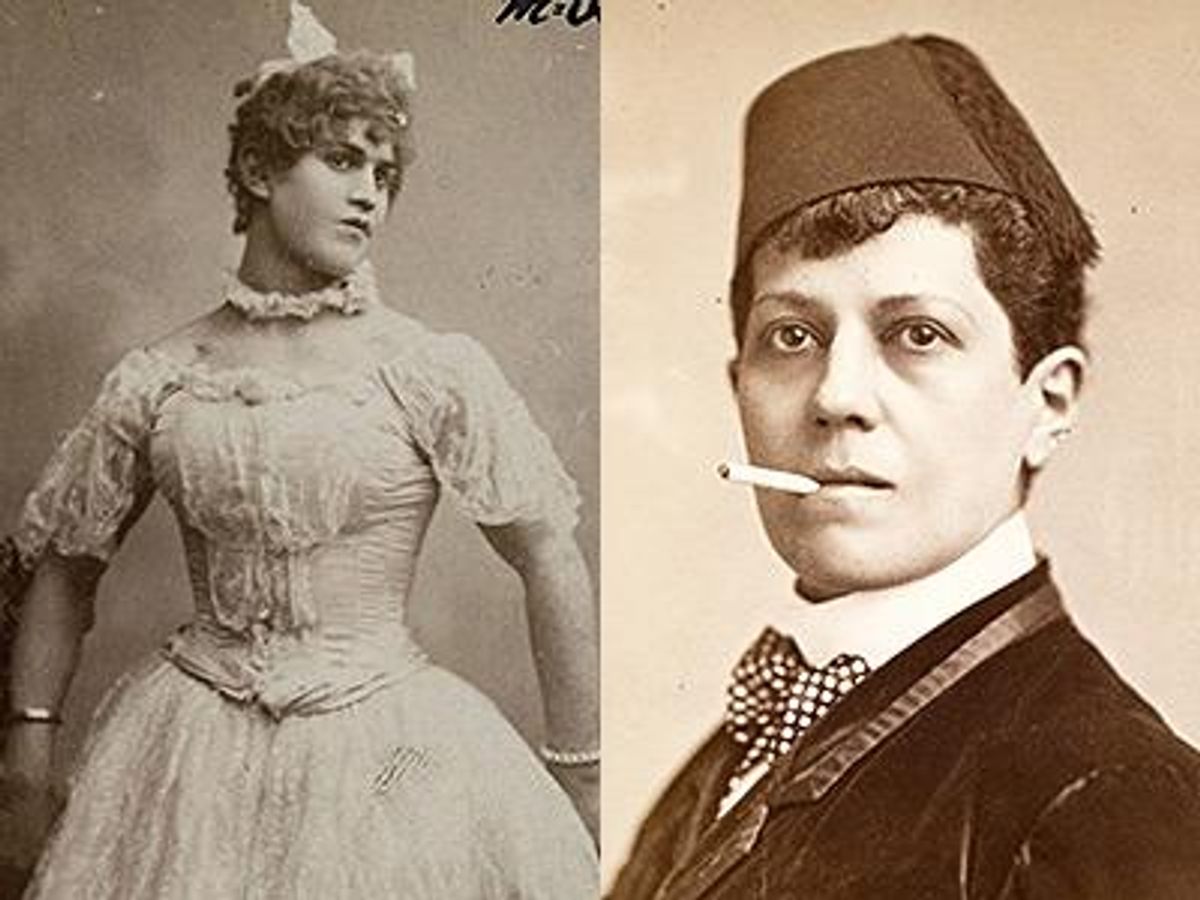

 At right: One of the nation's most famous female impersonators, William Horace Lingard
At right: One of the nation's most famous female impersonators, William Horace Lingard At left: Ella Wesner, male impersonator.
At left: Ella Wesner, male impersonator. Pictured above: Vesta Tilley, male impersonator.
Pictured above: Vesta Tilley, male impersonator. At right: Omar Kingsley, perfoming as Ella Zoyara
At right: Omar Kingsley, perfoming as Ella Zoyara At right: San Francisco's chief of police Jesse Brown Cook
At right: San Francisco's chief of police Jesse Brown Cook These include postcards of the actress Adah Isaacs Menken (pictured at left) in dashing male drag, as well as William Horace Lingard, the female impersonator who dazzled city audiences in 1871. Even more striking, Cook took part in an acrobatic troupe that included drag performances; when he was chief of police the department used a cartoon illustration of him wearing women's clothing to advertise their annual Valentine's Day ball. The cartoon is remarkable for its easy play with cross-gender and homoerotic symbolism; wearing drag and his chief 's hat, Cook asks the mayor to dance, since it is leap year, and the mayor coyly replies, "Well if you insist." However, despite Cook's clear and open appreciation for theatrical drag, he worked for and led a police force that persistently harassed and arrested people for crossdressing on the city streets. These arrests continued when he was chief of police (1908-10), and alongside his lovingly preserved collection of theatrical postcards, his scrapbooks contain crime scene photos and mug shots of people arrested for breaking cross-dressing law.
These include postcards of the actress Adah Isaacs Menken (pictured at left) in dashing male drag, as well as William Horace Lingard, the female impersonator who dazzled city audiences in 1871. Even more striking, Cook took part in an acrobatic troupe that included drag performances; when he was chief of police the department used a cartoon illustration of him wearing women's clothing to advertise their annual Valentine's Day ball. The cartoon is remarkable for its easy play with cross-gender and homoerotic symbolism; wearing drag and his chief 's hat, Cook asks the mayor to dance, since it is leap year, and the mayor coyly replies, "Well if you insist." However, despite Cook's clear and open appreciation for theatrical drag, he worked for and led a police force that persistently harassed and arrested people for crossdressing on the city streets. These arrests continued when he was chief of police (1908-10), and alongside his lovingly preserved collection of theatrical postcards, his scrapbooks contain crime scene photos and mug shots of people arrested for breaking cross-dressing law. Above: Julian Eltinge in Countess Charm.
Above: Julian Eltinge in Countess Charm. The Bella Union Vaudeville Theater in San Francisco's Barbary Coast on 1870
The Bella Union Vaudeville Theater in San Francisco's Barbary Coast on 1870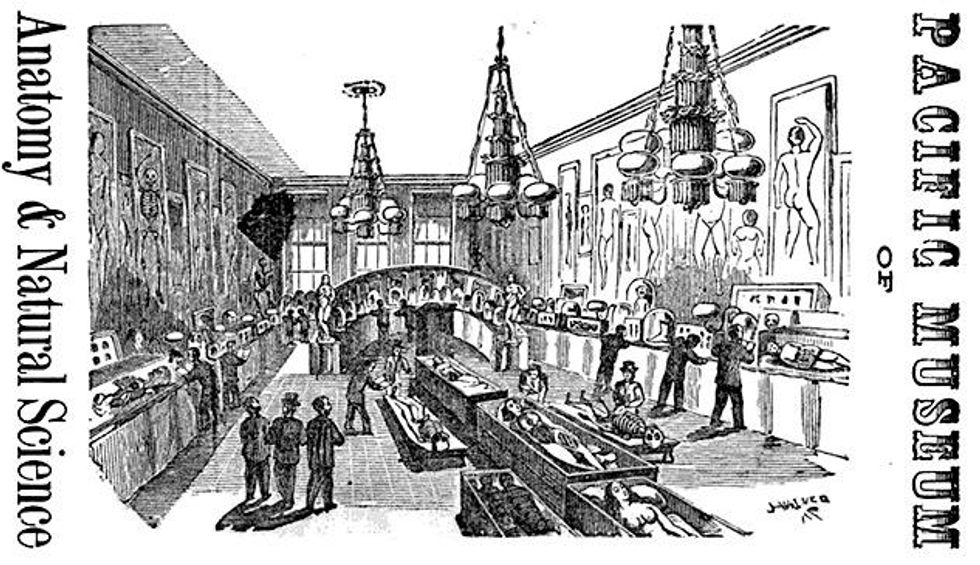
 d drawing exhibits at the Pacific Museum of Anatomy and Science, for example, was the preserved head of Joaquin Murietta, the notorious Mexican "bandit" who fought against Anglo dominance and violence in the southern mines before being killed by state-sponsored rangers in 1853. Murietta was a popular symbol of Mexican resistance, and the display of his severed head, "preserved in vinegar," graphically dramatized a narrative of Anglo dominance and Mexican defeat against the backdrop of the Mexican-American War. Occasionally dime museum exhibits explicitly linked gender and national boundary transgressions, as when Barnum's American Museum displayed a waxwork figure of Jefferson Davis, the defeated leader of the Confederacy, wearing women's clothing, at the close of the Civil War. (See image at left) This exhibit dramatized rumors that Davis had disguised himself in hoopskirts when trying to escape his Northern captors, deploying cultural anxieties about cross-gender practices to emasculate the defeated South, fortify territorial boundaries, and reconsolidate the postwar nation.
d drawing exhibits at the Pacific Museum of Anatomy and Science, for example, was the preserved head of Joaquin Murietta, the notorious Mexican "bandit" who fought against Anglo dominance and violence in the southern mines before being killed by state-sponsored rangers in 1853. Murietta was a popular symbol of Mexican resistance, and the display of his severed head, "preserved in vinegar," graphically dramatized a narrative of Anglo dominance and Mexican defeat against the backdrop of the Mexican-American War. Occasionally dime museum exhibits explicitly linked gender and national boundary transgressions, as when Barnum's American Museum displayed a waxwork figure of Jefferson Davis, the defeated leader of the Confederacy, wearing women's clothing, at the close of the Civil War. (See image at left) This exhibit dramatized rumors that Davis had disguised himself in hoopskirts when trying to escape his Northern captors, deploying cultural anxieties about cross-gender practices to emasculate the defeated South, fortify territorial boundaries, and reconsolidate the postwar nation. At right: Milton Matson
At right: Milton Matson Above: Newspaper sketch of Milton Matson, 1895. Caption reads, "Louise Elizabeth Merton Blaxton Matson, dressed in two of her best suits of clothes. [Sketched last week from life.]" San Francisco Examiner, February 10, 1895.Image courtesy of Duke University Press.
Above: Newspaper sketch of Milton Matson, 1895. Caption reads, "Louise Elizabeth Merton Blaxton Matson, dressed in two of her best suits of clothes. [Sketched last week from life.]" San Francisco Examiner, February 10, 1895.Image courtesy of Duke University Press. At left: Newspaper sketch of Milton Matson, 1895. Caption reads, "Louisa E. Metson [sic], who was betrothed to Miss Fairweather and is now in jail. [From a sketch made recently in Los Gatos.]" San Francisco Examiner, January 30, 1895.Image courtesy of Duke University Press.
At left: Newspaper sketch of Milton Matson, 1895. Caption reads, "Louisa E. Metson [sic], who was betrothed to Miss Fairweather and is now in jail. [From a sketch made recently in Los Gatos.]" San Francisco Examiner, January 30, 1895.Image courtesy of Duke University Press. While there are few historical records that speak to the disciplinary impact of cross-dressing performers on freak-show audiences, a dime novel that was popular at the time of Matson's performance is highly suggestive of possible effects. In Archibald Gunter and Fergus Redmond's 1891 novel, A Florida Enchantment, a wealthy white woman, Lillian Travers, purchases a box of African sex-change seeds from a dime museum in Florida. Following an argument with her fiance, she swallows a seed and transitions into a man named Lawrence Talbot. Realizing that a wealthy man needs a male valet rather than a female maid, Lawrence forces his "mulatto maid," Jane, to also swallow a seed and become a man named Jack. Lawrence later realizes with "fearful horror" that dime museums would love to exhibit him as a freak, and he has a nightmare in which the city is covered in gigantic dime museum posters, advertising him as "The Freak of All Ages" and "The Woman Man," appearing alongside "The Living Skeleton" and "The Missing Link". Although doubly fictional (appearing in both a novel and a dream), this scene illuminates the operations of the freak show in two specific ways.
While there are few historical records that speak to the disciplinary impact of cross-dressing performers on freak-show audiences, a dime novel that was popular at the time of Matson's performance is highly suggestive of possible effects. In Archibald Gunter and Fergus Redmond's 1891 novel, A Florida Enchantment, a wealthy white woman, Lillian Travers, purchases a box of African sex-change seeds from a dime museum in Florida. Following an argument with her fiance, she swallows a seed and transitions into a man named Lawrence Talbot. Realizing that a wealthy man needs a male valet rather than a female maid, Lawrence forces his "mulatto maid," Jane, to also swallow a seed and become a man named Jack. Lawrence later realizes with "fearful horror" that dime museums would love to exhibit him as a freak, and he has a nightmare in which the city is covered in gigantic dime museum posters, advertising him as "The Freak of All Ages" and "The Woman Man," appearing alongside "The Living Skeleton" and "The Missing Link". Although doubly fictional (appearing in both a novel and a dream), this scene illuminates the operations of the freak show in two specific ways. Above: Dime museum poster from the 1890s novel A Florida Enchantment. Archibald Clavering Gunter and Fergus Redmond, A Florida Enchantment: A Novel (New York: Hurst, 1891).Image courtesy of Duke University Press.
Above: Dime museum poster from the 1890s novel A Florida Enchantment. Archibald Clavering Gunter and Fergus Redmond, A Florida Enchantment: A Novel (New York: Hurst, 1891).Image courtesy of Duke University Press. Two years later, in nearby Stockton, a local newspaper relied upon the same freak-show characters to disparage cross-dressing practices, describing a person named Babe Bean (pictured left), who wore men's clothing on a body classed as female, as "the mysterious girl-boy, man-woman, or what-is-it?" These articles indicate the popular cultural currency of freak-show characters and hence the potential for freak shows to have diffuse disciplinary effects.
Two years later, in nearby Stockton, a local newspaper relied upon the same freak-show characters to disparage cross-dressing practices, describing a person named Babe Bean (pictured left), who wore men's clothing on a body classed as female, as "the mysterious girl-boy, man-woman, or what-is-it?" These articles indicate the popular cultural currency of freak-show characters and hence the potential for freak shows to have diffuse disciplinary effects. eak-show managers encouraged this questioning and occasionally brought in experts to heighten the drama. At New York's American Museum Barnum instigated a confrontation that ended in court, in which a freak-show visitor accused a Bearded Lady of being male, only to be rebuffed by the Lady's husband, father, and numerous doctors who testified that she was indeed female. Back in San Francisco, Matson's manager also went to court to sue his rivals who allegedly featured "fake" Miss Matsons in their shows; apparently there could be just one authentic Bogus Man. Far from resolving the gender confusion at hand, such events merely reminded audiences of their susceptibility to being duped. As such, freak shows not only reproduced the boundary between permissible and criminal gender displays that was policed by cross-dressing law; they also popularized and democratized it, turning audiences into aware and vigilant judges of possible gender fraud.
eak-show managers encouraged this questioning and occasionally brought in experts to heighten the drama. At New York's American Museum Barnum instigated a confrontation that ended in court, in which a freak-show visitor accused a Bearded Lady of being male, only to be rebuffed by the Lady's husband, father, and numerous doctors who testified that she was indeed female. Back in San Francisco, Matson's manager also went to court to sue his rivals who allegedly featured "fake" Miss Matsons in their shows; apparently there could be just one authentic Bogus Man. Far from resolving the gender confusion at hand, such events merely reminded audiences of their susceptibility to being duped. As such, freak shows not only reproduced the boundary between permissible and criminal gender displays that was policed by cross-dressing law; they also popularized and democratized it, turning audiences into aware and vigilant judges of possible gender fraud.


































